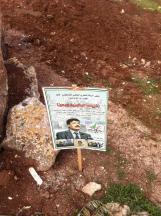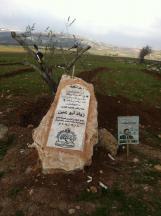Turmus Aya
09:00 We left the Rosh Ha’ayin train station.
On our way to the Za’tara/Tapuach junction we saw an armored military vehicle coming down from Harith toward the junction.
09:30 Za’tara/Tapuach junction. The junction is filled with election posters. Two soldiers stand opposite the bus stop and a third is in the guard tower. We continue on the road to Ramallah. We’re heading to Turmus Ay’ya where two weeks ago there were acts of vandalism, and not for the first time – cutting down olive saplings which had just been planted – by settlers from the neighboring Adey-Ad. Even before entering the village we see splendid homes on the side of the road, some of them four storeys high, roofs like pagodas, very imaginative architecturally. We’ll talk about these homes/palaces below.
The entrance to the village is also different from what we’re used to on the West Bank: a lovely archway joins both sides of the broad road which is lined by a row of colorful posters erected at regular intervals welcoming those arriving. At the entrance Nadim immediately identifies a local resident with a car who volunteers to lead us to the area. We follow him on a winding dirt road bordered on both sides by fenced, cultivated land interspersed with the truncated olive trees that had been sawed off by the settlers. Beyond them is a wide field filled with dozens of blue plastic ribbons. Our guide explains that the villagers tied the ribbons to the stumps of the cut saplings to mark their location and keep track of whether they survive. Adey-Ad’s few buildings are a short walk away. Another car soon arrives, with five young men, members of the families which own the olive groves. They came specially to have a sympathetic hearing, to describe the series of harassments by the settlements surrounding the village – Shiloh, Shvut Rachel. Eish Kodesh and, of course, Adey-Ad, who are signed off on the latest malicious act.
The young men restrain their anger as they tell us about the 5000 saplings cut down by the settlers; about the Supreme Court decision to return to the village land the settlers had appropriated but when the villagers came to cultivate it the army was called to expel them; about 70 complaints they filed which led to nothing; about farmers working in the fields who were attacked by the settlers. They said that in past years the villages sowed chickpeas, wheat and barley in those fields. The settlers waited until harvest time and then set fire to the crops.
October 12, 2014, is a date the villagers remember very well, and one that was widely reported in the Israeli media. On that day one thousand villagers went to plant olive seedlings, accompanied by representatives of the Palestinian Authority. The army had been notified in advance. The military representatives made a strange claim, that it was forbidden to plant without approval by the DCL. Ziad Abu Ayn, a Palestinian minister, led the demonstration. He also was the chairman of the committee to protect Palestinians from the settlers. The army confronted the demonstrators and tried to disperse them with tear gas. One of the soldiers attacked Abu Ayn, tried to choke him and hit him in the chest. Abu Ayn collapsed, lost consciousness and died. And what did the military authorities say? He died of a heart attack from excitement…

The young men stress that the Israeli media didn’t publish photographs showing the soldier hitting Abu Ayn in the chest, in order not to undermine the army’s version.
We stand before the memorial erected in his memory at the place he died. Beside it – his photograph and biography. Behind it – an olive tree that had been cut down, but which came back to life and whose branches are budding. Some of them are decorated with kaffiyehs and Palestinian flags in his memory.
We return to the village. Its streets are paved, there are many fancy, stylish homes, broad, two-lane local streets with signage, pedestrian crosswalks, very clean. A Bank of Palestine branch. A money-changer, lovely show windows. A very unusual local sight on the West Bank. At the entrance to the shining municipal building is a surprise: an elevator!!! We ascend to the second floor, enter a spacious conference room, tastefully furnished. W., the vice-chairman of the municipality welcomes us and S., the municipal engineer, joins us. They recount Turmus Ay’ya’s unusual story:

The village has some 3500 residents but only some live there. More than 1000 of the residents, mostly younger ones, live abroad, most of them in the United States. In Chicago, for example, there’s an entire community of people from Turmus Ay’ya. Relatives from abroad visit during the summer. The lovely homes we saw belong to them. They’re empty most of the year but inhabited by relatives, most of them elderly, who remained in the village, and during the summer the visitors live in them. There’s a very strong connection between those living in the village and those living abroad. They love the village and invest money in it (the municipal building was donated by one of them). They support their families in the village financially. The relatives abroad send their children (usually accompanied by their mothers) to the village for four or five years to absorb Arab culture and the language and to connect them to the village.
Why do so many young people leave and go abroad? W., an impressive man, well-dressed, pleasant, fluent in English, who lived many years in the United States, a graduate of a university in Chicago and an American citizen, explains:
Migration from the village is part of an ongoing process in the West Bank which already began in 1967 with the start of the occupation. It later increased because of the difficult economic conditions resulting from the unemployment created by the occupation authorities. Most of the young migrants have graduated from West Bank universities. Each year 25,000 young people finish their studies and receive an academic degree. Only very few of them manage to find work in their field on the West Bank. W. is a sad example: three of his four children have emigrated. Only one daughter managed to find a job in her field and remained in the village. Even those lucky enough to be employed by the Palestinian Authority have economic difficulties because they receive only half their salary. So even though the village has elegant buildings and seems unusually attractive, it pays a heavy price: an unnatural demographic structure, divided families, an elderly population doomed to isolation and loneliness and many trans-oceanic yearnings…
And what about those who stay? The unemployment rate is 40%. 5000 dunums of village land were expropriated for the settlers. One resident filed 39 claims since 1994. They’re all collected in a file we are shown. Some are stamped “unknown,” regarding others the claimant is asked to “be patient, it may take a while”… How long, exactly???
Is there a possibility for a better future? Both W. and S. are skeptical. They don’t think the Israeli elections will change the political situation so the chances of a political solution are almost zero. They believe both Fatah and Hamas will support an agreement on condition that 25% of the West Bank will be returned to Palestine. But you need two sides for an agreement…
12:45 We left Turmus Ay’ya. Six more soldiers in the parking lot at the Za’tara/Tapuach junction.
13:30 Back in Rosh Ha’ayin.
